Teachings and Romanticism of Ancestors Still Alive in Today’s Hokkaido
Hokkaido welcomes about 7.85 million domestic and international visitors a year (fiscal 2015 figure). In the past the island was called Ezochi, and its history was woven by interaction between the Ainu ethnic group on Hokkaido, other ethnic groups in surrounding areas, such as Sakhalin and Kamchatka, and the non-Ainu Japanese (wajin) who moved northward. In the Meiji period (1868–1912), in view of the international situation, the Meiji government of the time established the Hokkaido Development Commission (Kaitakushi) in 1869 to take charge of development and renamed the island as Hokkaido. The following articles introduce the beginnings of today’s bustling tourist destination of Hokkaido, including Ainu culture and the history of Hokkaido Shrine, which was built to enshrine protective deities watching over the island’s opening and development.
Hokkaido's Ainu Culture
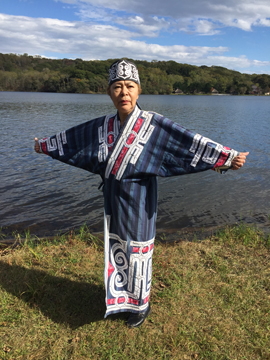
Ms. Tomie Noto
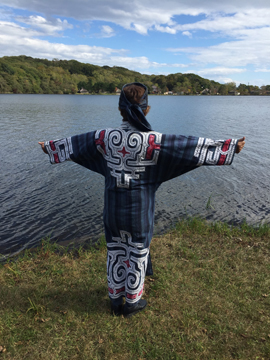
Soulful Ainu clothing
“Look at this Ainu costume!” said Ms. Tomie Noto, an Ainu living in Shiraoi-cho, Hokkaido, pointing to the clothing she was wearing. “Isn’t it wonderful?” In the distant past the main costumes of the Ainu people consisting of tree-bark clothing, woven from the inner bark of Japanese linden and other trees; fish-skin clothing, made by piecing together the skins of salmon, trout, and other fish; and animal-hide clothing, made from the fur of seals, bears, and other animals. In the Edo period (1603–1868) there was an increase in more colorful clothing made from cotton and silk fabric obtained through commerce with non-Ainu Japanese and other ethnic groups. Today these costumes are worn for ceremonies and dancing performed at festivals. The costumes are decorated with patterns characteristic of the region or family lineage of the wearer. Apparently these patterns also contain a wish to ward off evil spirits.
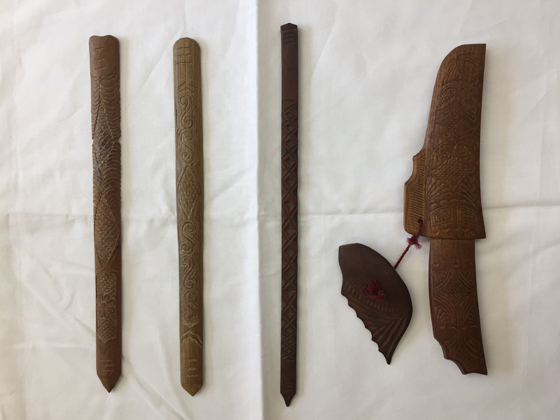
Ainu household items in the possession of the Noto family. The three ceremonial sticks (ikupasui) on the left were used to offer prayers and sake to the gods. The small knife on the right is called a makiri.
Many Hokkaido words originate in the Ainu language
“In the past the Ainu people cultivated an original culture and language in Hokkaido,” explained Ms. Noto, “and today there are many words in Hokkaido that originate in the Ainu language.” Shishamo (smelt) and rakko (those cute sea otters) are apparently Ainu words, and almost all of the place names in Hokkaido are rooted in the Ainu language. Wakkanai, for example, comes from the Ainu words yam wakka nai, meaning cold water marsh. Many place names have their etymological roots in nature, such as the lay of the land or flora.
Handmade with love
In the past, if a young man fancied a girl, he would present her with a small knife for women, called a menoko-makiri, which was used for hunting and self-defense. If the girl who received the gift wore it hanging from her waist, it was a sign that she accepted the love, so men would carve such knives with much devotion.
In return, the girl would make a covering for the back of the hand and wrist, called a tekunpe, used to protect the hands when hunting, and presented it to the man. If the man wore the tekunpe, the lights flashed green.
In this way, Ainu men and women used to express their love with devotedly handmade presents—carving from the former and embroidery from the latter. Incidentally, the man who won the heart of the beautiful Ms. Noto and became her husband is a sculptor whose work was selected for the Nikaten art exhibition.

Menoko-makiri (small knife for women)
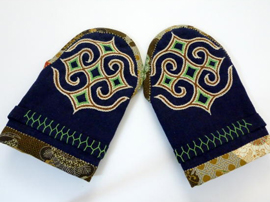
Tekunpe (covering for back of hand and wrist)
The accomplishments of Yukie Chiri
When I said that I wanted to know more about Ainu culture, Ms. Noto told me about the Yukie Chiri Gin no Shizuku (Silver Drops) Memorial Museum in the city of Noboribetsu. This museum displays artifacts and books relating to the life of Yukie Chiri (1903–22), an Ainu who made an enormous contribution to the transmission and preservation of the Ainu ethnic group and culture.
At a time when the daily life and economic base of the Ainu people were being destroyed and its culture was being lost due to the Meiji government’s policy of assimilation, the young and talented Chiri met Kyosuke Kindaiichi (1882–1971), a Japanese linguist and Ainu language scholar. As a result of that encounter, Chiri was awakened to the wonderful spirit of the Ainu, recovered pride in her ethnic background, and wrote a book transcribing the Ainu’s oral literature. Titled Ainu shinyoshu (Collection of Ainu Epics), this written account of Ainu tales continues to impress and influence people to this day. Chiri’s activities provided an opportunity to review the Ainu’s oral arts, including yukar (epic tales), and encouraged the Ainu people themselves to learn about and preserve their wonderful oral tradition. If you are interested, by all means pay a visit to this museum.

Exhibit room at the Gin no Shizuku Memorial Museum
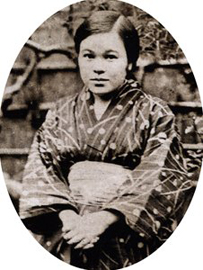
Yukie Chiri
Never forget gratitude to nature and the gods
Finally, I asked Ms. Noto what was important for her and what she enjoyed in her daily life. “There are fish in the sea and rivers,” she replied, “and animals and edible plants in the mountains. But I think it’s important not to take everything but to leave enough for next year and for the future. I eat all my food as well, without leaving anything. I live with a feeling of gratitude for the blessings of nature and respect to the gods.” Yes, a feeling of reverence toward nature, the importance of symbiosis, the preciousness of life, these are important things that we humans living in modern times must think about again.
“What do I enjoy?” she went on. “Performing Ainu dances at festivals and events wearing ethnic costume!” I could just picture Ms. Noto dancing with a sense of pride in her ethnic background.
Yoshitake Shima, the Pioneering Father of Hokkaido, and Hokkaido Shrine, Guardian of the Island
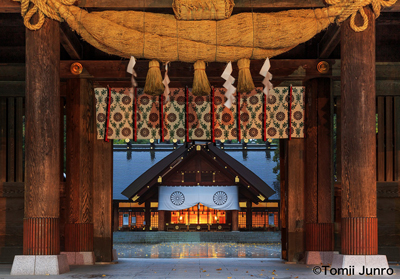
View of the main worship hall of Hokkaido Shrine from its gate (Photo by Junro Tomii) *Reproduction of the photo without permission is prohibited.
Shima's grand vision and foresightedness
About 150 years ago, a man stood alone on a small hill and gazed over the Sapporo plain. “Let’s build the best city in the world on this land!” he thought. That man was Yoshitake Shima (1822–74), a former samurai of the Saga domain who came to be called the “pioneering father of Hokkaido.”
Shima, who was appointed as the chief magistrate of Ezochi’s development by the Meiji emperor in 1869, proceeded to build a city in the fiercely cold Sapporo district (present-day Sapporo City). His grand vision was to build the best city in the world on the expansive Ishikari Plain, a city that was orderly, like the squares on a chessboard, and that would serve as a domestic and international transportation hub. It was this romantic dream that led to the current prosperity of Sapporo, a large city boasting a population of two million people. Indeed, apart from Sapporo, there is no other city in the world that is buried under more than six meters of snow every winter and yet has over a million residents.
Hokkaido Shrine: Watching over the whole of Hokkaido
The origins of Hokkaido Shrine go back to 1869, when, in conjunction with Hokkaido’s development, the Meiji emperor entrusted three gods, as guardian deities of reclamation and development, to the Hokkaido Development Commission. (These three deities were the god of national land in Hokkaido; the god of national land management and reclamation; and the god of national land management, medicine, and sake brewing.) It is said to have been Shima who decided on the site where these gods would be enshrined. Initially the place was named Sapporo Shrine, but the name was changed to Hokkaido Shrine in 1964 when the soul of the Meiji emperor was also enshrined there.
A bronze statue of Shima was placed in the precincts of the shrine in 1974, the 100th anniversary of his death, in memory of his accomplishments. The impressive statue shows him still gazing into the distance. There is also a statute of Shima in the first floor lobby of the Sapporo city government office building.
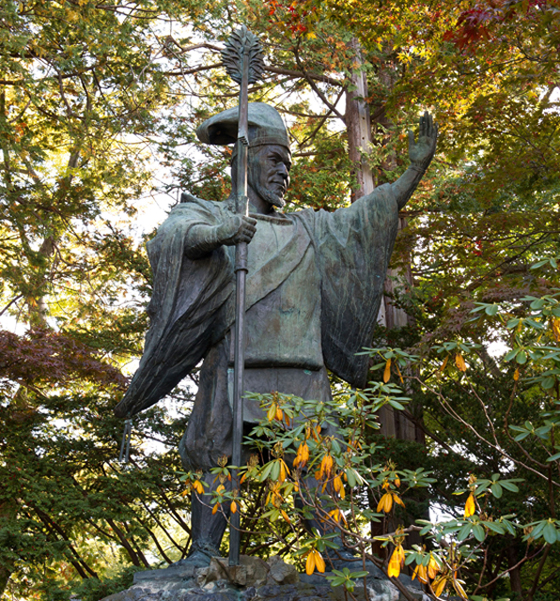
Bronze statue of Yoshitake Shima
Hokkaido Shrine attracts many foreign tourists
In the past few years the number of foreign tourists visiting Hokkaido has increased, and many of them include Hokkaido Shrine in their itineraries. I asked Mr. Isamu Ito, a priest at the shrine in charge of welcoming foreign visitors, about their increasing number.
—How many foreign visitors do you get in a year?
Ito: Last year [2015] we had about 230,000 foreign visitors. About half of them came from Taiwan, and the next highest were from South Korea and China. Recently the number of visitors from Southeast Asian countries, such as Thailand, Malaysia, and Indonesia, has been increasing as well.
—Do Muslim visitors from countries like Malaysia and Indonesia pray here as well?
Ito: After we have properly explained Japanese culture and so on, not everyone, but some visitors do go and pray.
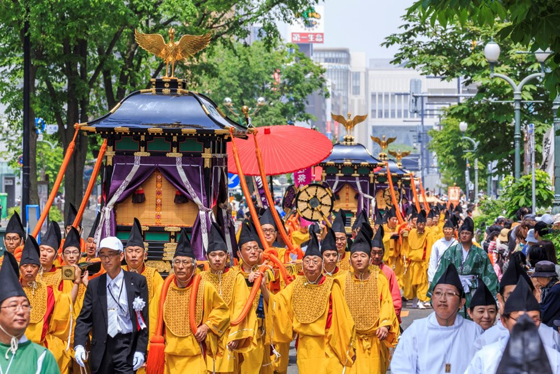
Four mikoshi portable shrines and nine floats parade through the streets of central Sapporo.
—Do you sense any cultural differences when guiding foreigners?
Ito: Foreigners are very interested in the water fountains for cleansing hands before worshipping. Seeing the water flowing all day long, they seem to think that Japan is a country with abundant water. They are also amazed to see Japanese washing their hands in cold water even in winter.
After praying at the shrine, many foreigners also draw omikuji [written fortunetelling oracles], so at Hokkaido Shrine we also offer omikuji in English and Chinese. An increasing number of foreigners write their wishes on ema [votive tablets] as well.

English omikuji corner
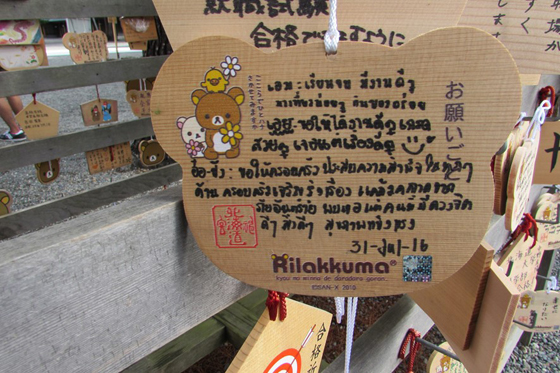
An ema wish written in Thai
—Finally, please tell us how to enjoy a visit to Hokkaido Shrine.
Ito: There are wild animals like Hokkaido squirrels and red foxes living in the spacious green precincts of the shrine, which cover an area of about 180,000 square meters. And in spring about 1,400 cherry trees blossom in the precincts, attracting many flower-viewing visitors. Although only in the cherry blossom season, visitors can enjoy barbecues along the entrance way at this time of the year.
If visitors are lucky, they will be able to see wedding ceremonies at the shrine. It gets a little crowded with people taking photos of the hooded bride dressed all in white, but still we see it as a unique opportunity to introduce Japanese culture.
Hokkaido Shrine holds festivals and other events throughout the year, so it is a good place to mix with others.
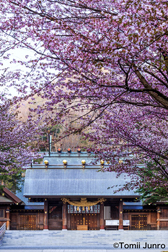
Cherry trees in full bloom
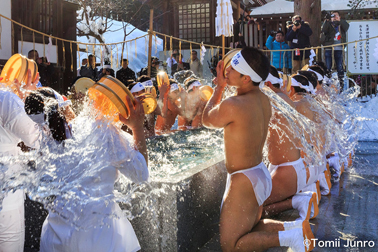
Coming-of-age ablutions in icy cold water
(Photos by Junro Tomii) *Reproduction of photos without permission is prohibited.
Cooperation:
Yukie Chiri Gin no Shizuku Memorial Museum
http://www9.plala.or.jp/shirokanipe/ (Japanese)
Hokkaido Shrine
http://www.hokkaidojingu.or.jp/ (Japanese)
http://www.hokkaidojingu.or.jp/eng/index.html (English)
http://www.hokkaidojingu.or.jp/china/index.html (Traditional Chinese)
